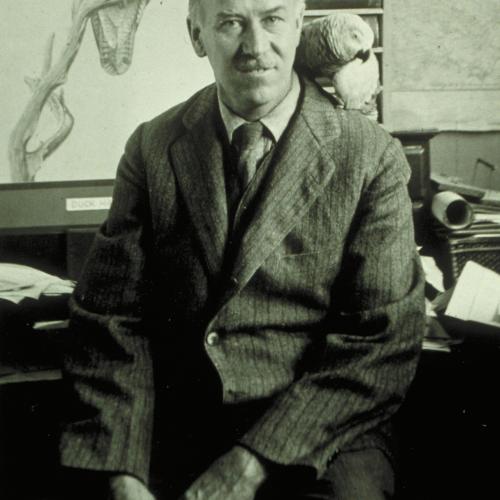
(Louis Agassiz Fuertes Papers, #2662. Division of Rare and Manuscript Collections, Cornell University Library.)
Louis Agassiz Fuertes (1874–1927) was an ornithologist, artist, and illustrator. Fuertes was born into a scientific home—his father, Puerto Rican astronomer and civil engineer Estevan Fuertes, even named him after naturalist Jean Louis Rodolphe Agassiz.
Fuertes became interested in studying and drawing birds at an early age, but didn’t seriously pursue it until after graduation from Cornell University in 1897. He eventually travelled all over North America, as well as to Columbia and Ethiopia to study birds and create scientific illustrations of them. He worked on projects and did speaking engagements for Cornell University, the Field Museum, and the American Museum of Natural History (where his mural of a Flamingo Colony is in the Hall of North American Birds). As an artist and illustrator, Fuertes created illustrations for over 60 publications during his career. Known for his meticulous attention to detail, he studied birds in their habitats and gathered specimens to ensure the highest level of realism. Fuertes also has two birds named after him, Fuertes’s Parrot (Hapalopsittaca fuertesi) and Fuertes’s Oriole (a subspecies of the Orchard Oriole, Icterus spurius fuertesi).
In 1904, Fuertes was commissioned by then New York State Museum Director, John Mason Clarke, to provide illustrations for an extensive research study on the state's bird species. The resulting publication, Birds of New York (published in 2 volumes, 1910 and 1914), was a groundbreaking work that combined scientific rigor with artistic beauty. Written by Elon Howard Eaton, a biology teacher and naturalist, the book featured extensive research on the state's bird species, including migration patterns, distribution maps, and behavioral observations. What truly set this publication apart was the stunning artwork by Fuertes, whose vivid bird illustrations brought the text to life. Celebrated for its depth and accessibility, Birds of New York not only became a valuable resource for ornithologists but also sparked a lasting interest in bird conservation and study across the state. Even 100 years after its initial release, it continues to hold significance for ornithologists and bird enthusiasts alike.
In 1915, the New York State Museum acquired 120 of the original Birds of New York watercolor paintings by created by Fuertes, a gift of Margaret Olivia Slocum Sage (Mrs. Russell Sage).
In 2020, several reproductions of these watercolors were added to the NYSM's renovated Birds of New York Hall. We invite you to visit the gallery to see them in person, or view them individually below!